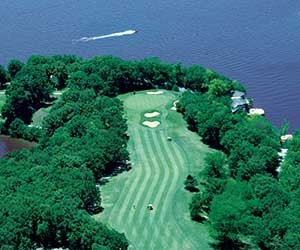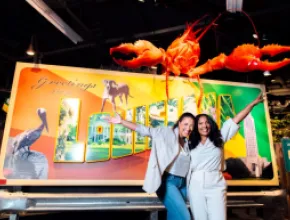Central Missouri occupies a nice perch between the Show Me State’s two economic powerhouses, Kansas City and St. Louis. It includes the state capital, Jefferson City, plus the thriving college town of Columbia and the 54,000-acre aquatic playground known as the Lake of the Ozarks.
For groups, the region is a land of interesting historical, cultural and recreational opportunities, and there are plenty of meeting venues to accommodate gatherings.
Jefferson City
The state government is the main employer in Jefferson City (named after Thomas Jefferson), accounting for between one-third and one-half of all jobs. This, combined with the city’s central location within Missouri, naturally leads to a certain amount of association business, but sports- and history-minded groups can also easily find a home here.
The Jefferson City CVB’s “You’ll Feel the History” slogan is especially relevant as the 150th anniversary of the Civil War years proceeds, since the city, while Confederate-leaning, was occupied early on by Union troops. It evolved into a giant army camp with up to five times more soldiers than citizens, and usable buildings became so scarce that the basement of the beautiful Missouri State Capitol was pressed into service as a jail.
The Jefferson City CVB has been running a “Civil War in Jefferson City” program that encourages visitors to check out the destination’s many sites relating to the War Between the States. Response to this program, which includes places such as the National Cemetery, Museum of Missouri Military History, Lincoln University Soldiers Memorial Plaza (commemorating African American veterans of the war), Dulle House (headquarters of Union general John Fremont), and General Parsons Monument (commemorating Missouri Confederate general Mosby Monroe Parsons) has been excellent, says Marianne Thies, sales manager at the Jefferson City CVB.
These sites are important, Thies says, because Missouri has the distinction of being both a Union and a Confederate state; white Missourians fought in both grey and blue uniforms—and remarkably for the time, Union infantry units composed of freed Missouri slaves fought for the North.
“We have had bus tour operators that have chosen Jefferson City for the Civil War tour,” Thies says. “With our special Civil War itinerary we even offer an authentic Civil War lunch at the G2 Gallery and we can arrange for ‘Abe Lincoln’ to join your group. It’s always nice for any conference or convention with free time to add in a dose of Missouri history.”
Jefferson City also promotes itself as a sports destination to both locals and visitors through JeffersonCityOutdoors.com, according to Thies.
“We wanted a place where visitors could go to learn, collectively, about all the events we offer when they are making travel plans. It’s also an extremely useful tool to attract sports planners to our area so they can see just how successful other events are and so they are more aware of our landscape and the options in Jefferson City.”
Those attractions include hiking and biking the Katy Trail, visiting Runge Nature Center, or playing at any of several public and private area golf courses.
Even in the face of plentiful Civil War history, outdoor attractions and a State Capitol with an interior that was once named the nation’s most beautiful by USA Today, Thies says tours of the once-notorious Missouri State Penitentiary—closed since 2004—are actually Jefferson City’s biggest tourism draw.
Jefferson City is an ideal meeting point for many reasons, according to Thies.
“We are centrally located and value priced, and have many historic attractions with free admission,” she says. “We love to show [groups] our hospitality—and they will return again and again.”
The three largest meetings-friendly properties in town are the Capitol Plaza Hotel and Convention Center, Truman Hotel and Conference Center and DoubleTree Hotel Jefferson City.
Columbia
Where Jefferson City is Missouri’s political capital, Columbia is undoubtedly its educational capital, thanks to the flagship University of Missouri campus. As any U. of M. grad will know, this was the first public university west of the Mississippi and the first state university of any kind in the entire Louisiana Purchase.
Nowadays Columbia is a college “town” of 110,000 that tends to rack up quality-of-life awards from magazines such as Money and Men’s Journal. Anyone who’s not a student or an employee at the University of Missouri (nicknamed “Mizzou”) or several other colleges likely works for one of the area’s numerous healthcare or insurance companies.
The bulk of Columbia’s meetings business is composed of associations, sports groups and government groups, with educational groups flocking here as well to take advantage of Mizzou’s reputation in fields such as medicine, journalism, law and veterinary science. Having experienced success in attracting statewide conferences, Columbia CVB’s next target is regional meetings, according to sales and tourism marketing manager Beth Mead, who sees Columbia’s cultural attractions as a powerful draw.
“Columbia is fortunate to have a wealth of cultural opportunities year-round, ranging from visual art exhibits, performing arts, wine and food events, festivals of all kinds (art, music, heritage, food) and more,” she says. “Columbia is a regional leader in the arts, and our events are loyally attended by citizens of Columbia [and] visitors from around the state and region.”
Columbia’s three largest conference spaces can be found at the Holiday Inn Executive Center, Stoney Creek Inn and Hilton Garden Inn.
The city offers several unique meeting venues, such as the Missouri Theatre, a beautifully renovated pre-Depression movie palace; art spaces such as PS:Gallery and Orr Street Studios that work well for receptions or small dinners; the Blue Note, a former Vaudeville-style theater turned music club; and Museao, a modern steel, glass and concrete space with 30-foot ceilings and an easily modified floor plan that groups can shape to their needs.
Lake of the Ozarks
No matter what part of the state they’re from, Missourians enjoy road-tripping to and vacationing at the Lake of the Ozarks, a 54,000-acre reservoir created when the Osage River was dammed in 1931. Local topography lends this massive body of water a serpentine shape, inspiring its nickname “The Magic Dragon.” To give an idea of just how much shoreline the dam created, Lake of the Ozarks has 1,150 miles of freshwater coast—more than the entire state of California.
While Lake of the Ozarks ensured a water supply and hydroelectric power for a large swath of the state, it also created plenty of recreational opportunities and spurred the growth of communities such as Camdenton, Eldon, Lake Ozark, Lake West and Osage Beach. While these towns are animated by summer activities on the lake, including boating and fishing excursions, the lake area’s 14 golf courses are also a huge draw, as is the Osage Premium Outlets in Osage Beach, Missouri’s largest outlet mall.
The Camden on the Lake Resort, Spa & Yacht Club, Country Club Hotel & Spa, Inn at Grand Glaize, Lodge of Four Seasons, Resort at Port Arrowhead and Tan-Tar-A Resort anchor the area’s meetings business and all have meeting spaces, restaurants and banquet facilities.
There are dozens of other group-friendly properties in the Lake of the Ozarks, which features 350,000 total square feet of meeting space.
As with other Central Missouri locations, the Lake of the Ozarks area gets to draw on business from around the state and the region, according to Lagina Fitzpatrick, director of sales at the Lake of the Ozarks CVB.
“We get heavy association business since we are in the center of the state, and also on the corporate side, we can draw regional corporate meetings from Kansas City and St. Louis, as well as quite a few family reunions,” Fitzpatrick says, adding that the Lake of the Ozarks is a year-round destination whose accessibility is largely unaffected by the seasons.
Paul D. Kretkowski writes frequently about travel, food and sports. He is also the founder of Beacon, a blog about foreign policy.





